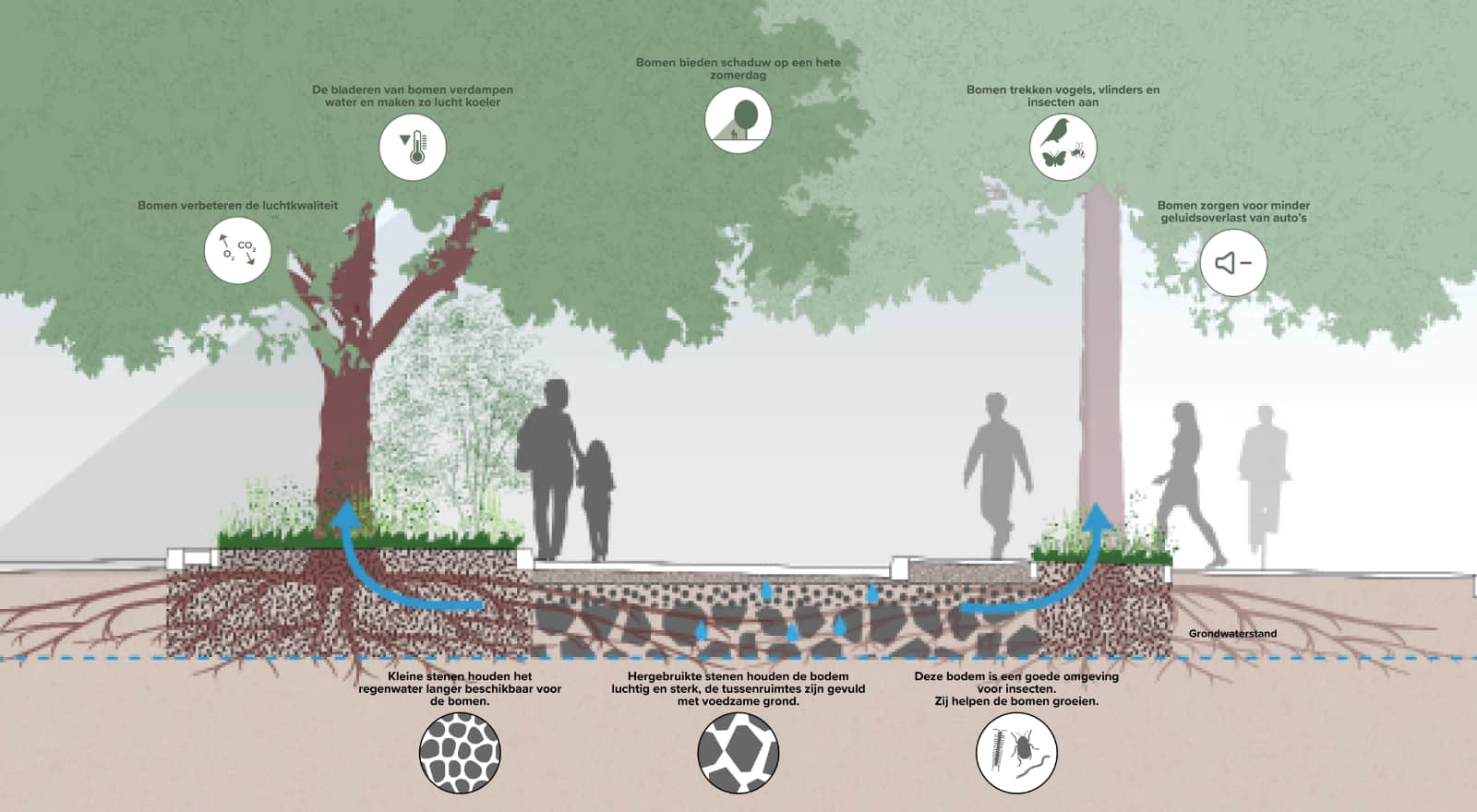Vital Soil as Foundation for Future Proof Urban Forestscapes - Experimenting in Real Time Locations with Different Actors in The Hague
Downloads
DOI:
https://doi.org/10.47982/spool.2025.1.08Keywords:
Biodiversity, co-creation, landscape architecture, residents, soil health, transdisciplinary research, urban forest, urban green space, urban transformationAbstract
This essay reports on a ‘living lab’ approach to develop a new understanding of below- and above-ground ecological processes as the foundation for robust urban forest habitats. This experimental approach includes a series of design and implementation projects in the city of The Hague, the Netherlands. In contrast to mainstream greening projects led by local governments, these experiments enable urban trees to form more robust forest-like systems by creating a symbiosis between soil (organisms), trees, plant communities, and species. As implemented reference projects are limited, a learning-by-doing methodology was adopted. A transdisciplinary team, consisting of landscape architects/designers, arborists, botanists, municipal and private green space maintenance organizations, has initiated, implemented, and monitored a series of pilot projects. Analysis of ten natural reference locations in the surrounding countryside has helped to define natural and forest-like soil conditions and plant communities for the three living lab locations in the city. Local residents have been engaged in the design, implementation and maintenance process. Sharing insights so far contributes to the transition of reconnecting soil, nature, and people in cities.
How to Cite
Published
References
Akoijam, R., Bhattacharyya, B., & Marangmei, L. (2013). Tullgren funnel—An efficient device for extracting soil microarthropods. Environment & Ecology, 32(2), 474–476.
Darwin, C. (1882). Humusvorming door wormen, met observaties over hun levenswijze (T. Ouderaa van der, Trans. 7th ed.). John Murray.
Day, S. D., & Bassuk, N. (1995). Effects of four compaction remediation methods for landscape trees on soil aeration, mechanical impedance and tree establishment. Journal of Environmental Horticulture, 13(2), 8. Retrieved from https://www.researchgate.net/publication/285403998 DOI: https://doi.org/10.24266/0738-2898-13.2.64
Embrén, B. (2009). The Stockholm solution—Ten years of experience of urban tree planning and management combined with local stormwater management.
Embrén, B. (2015, June 22). Trees and stormwater management: The Stockholm solution.
Embrén, B. (2016). Planting urban trees with biochar: The Stockholm Project. The Biochar Journal, 44-47. https://www.biochar-journal.org/en/ct/77
Gemeente Den Haag. (2021). Voorstel van het college inzake Nota stadsbomen. In https://denhaag.raadsinformatie.nl/modules/13/Overige%20bestuurlijke%20stukken/648764 (No. RIS307827). Retrieved January 19, 2024, from https://denhaag.raadsinformatie.nl/document/9741070/2?connection_type=17&connection_id=7018927
Heyman, H., Bassuk, N., Bonhotal, J., & Walter, T. (2019). Compost quality recommendations for remediating urban soils. International Journal of Environmental Research and Public Health, 16(17), 3191. DOI: https://doi.org/10.3390/ijerph16173191
Konijnendijk, C. C. (2022). Evidence-based guidelines for greener, healthier, more resilient neighbourhoods: Introducing the 3–30–300 rule. Journal of Forestry Research. https://doi.org/10.1007/s11676-022-01523-z DOI: https://doi.org/10.1007/s11676-022-01523-z
Livesley, S. J., McPherson, E. G., & Calfapietra, C. (2016). The urban forest and ecosystem services: Impacts on urban water, heat, and pollution cycles at the tree, street, and city scale. Journal of Environmental Quality, 45(1), 119–124. https://doi.org/10.2134/jeq2015.11.0567 DOI: https://doi.org/10.2134/jeq2015.11.0567
Müller-Inkmann, M. (2020). Regenwürmer—Vielseitige Bodeningenieure mit Nutzen für Bäume [Earthworms—Versatile soil engineers with benefits for trees]. In Jahrbuch der Baumpflege 2020 (pp. 181–194). Haymarket Media GmbH.
Percival, G. C., Graham, S., & Franklin, E. (2023). The influence of soil decompaction and amendments on soil quality. Arboriculture & Urban Forestry, 49(4), 179–189. https://doi.org/10.48044/jauf.2023.012 DOI: https://doi.org/10.48044/jauf.2023.012
Roman, L. A., & Scatena, F. N. (2011). Street tree survival rates: Meta-analysis of previous studies and application to a field survey in Philadelphia, PA, USA. Urban Forestry & Urban Greening, 10(4), 269–274. https://doi.org/10.1016/j.ufug.2011.05.008 DOI: https://doi.org/10.1016/j.ufug.2011.05.008
Sax, M. S., Bassuk, N., van Es, H., & Rakow, D. (2017). Long-term remediation of compacted urban soils by physical fracturing and incorporation of compost. Urban Forestry & Urban Greening, 24, 149–156. https://doi.org/10.1016/j.ufug.2017.03.023 DOI: https://doi.org/10.1016/j.ufug.2017.03.023
Smith, I. A., Dearborn, V. K., & Hutyra, L. R. (2019). Live fast, die young: Accelerated growth, mortality, and turnover in street trees. PLOS ONE, 14(5), e0215846. https://doi.org/10.1371/journal.pone.0215846 DOI: https://doi.org/10.1371/journal.pone.0215846
Smith, J., Potts, S., & Eggleton, P. (2008). Evaluating the efficiency of sampling methods in assessing soil macrofauna communities in arable systems. European Journal of Soil Biology, 44(3), 271–276. https://doi.org/10.1016/j.ejsobi.2008.02.002 DOI: https://doi.org/10.1016/j.ejsobi.2008.02.002





